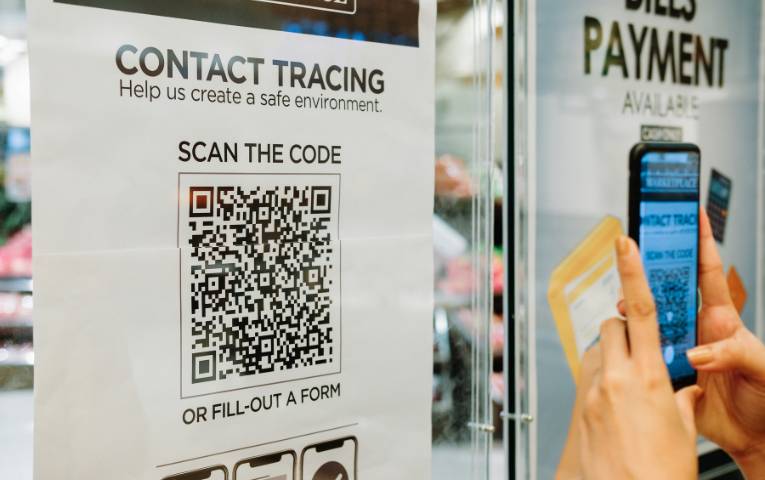QR code history has taken an interesting journey over the last few years. Prior to the COVID-19 pandemic, QR codes were virtually non-existent to consumers. In an effort to limit contact, restaurants everywhere started replacing their menus with little pieces of paper that had a black square code on it. While some consumers might have been confused at first, the ease of using a QR code quickly caught on. All you had to do was open the camera on your cell phone, hover over the QR code and an internet pop-up would appear. Clicking on the pop-up would direct users to the website page where the business wanted consumers to go. The trend caught on quickly and now every business is using QR codes in one way or another.
When was the first QR Code created?
Many people would be surprised to know that QR codes have been around since 1994. When Japan entered its high economic growth period in the 1960’s, an increase in supermarkets selling a wide range of commodities caused an issue for cash registers. At the time, cash registers had to key in each product manually and many cash registers were suffering from carpal tunnel syndrome. This led to the creation of barcodes and subsequently the POS system, but there were still limitations as barcodes could only hold 20 alphanumeric characters. The codes also could not accommodate Kanji and Kana characters that are used in the Japanese language.
How were QR codes created?
Denso Wave Incorporated was a division of Denso Corporation at the time and was developing barcode readers for the company. They sought to create barcode readers that could hold more information and knew the barcode would have to be very unique to not be mixed up with other barcodes. In order to create the sought-after code, Denso Wave had to find a way to make a 2D code. Normal barcodes can only be scanned in one specific direction, which also aids in their limitation to hold more information. A 2D code could be scanned in virtually any direction and would be able to hold more information. It took a year and a half, but after repeated trial and error, the QR code was capable of coding about 7,000 numerals and had the capability to code Kanji characters. It was called the “quick response” code because it could be read more than 10 times faster than other codes.
Immediately, the auto industry and other manufacturers adopted the QR code into their daily processes to help manage the work more efficiently. When consumers demanded for transparency in the food industry to know where the food products were coming from, food and pharmaceutical companies began to use the code to control their merchandise. Denso Wave also elected to have the QR code made publicly available so that anyone could use it freely. By 2002, the QR code was widespread among the general public in Japan and was starting to gain traction in other countries.
QR Code History in the United States
However, the QR code did not gain popularity in the United States until years later. This delay can be largely contributed to our cell phones. Prior to 2017, cell phones in the U.S. were not equipped to scan QR codes and consumers would have to download a separate app to scan QR codes. The iOS 11 update released in September 2017 finally allowed iPhone users to be able to scan QR codes with their camera. Google quickly followed suit with their Android updates. Even though both updates allowed 274.1 million U.S. consumers the ability to scan a QR code, it still took 3 years for the marketing trend to be recognized by consumers.
QR Code Marketing
The future of QR codes is still unknown, but we do know they are not going away anytime soon. Today, more than 82% of U.S. consumers aged 18-44 use QR codes to gain more information about a business. QR codes have opened a door to an entire new world of advertising that can engage consumers beyond printed advertising. It is a commonly used feature to spread brand awareness about a business, share contact information, to view videos, or direct consumers to a website form. You can even track how many people have scanned the QR code and when they scanned it. This is a great tool to pair with a mail piece or brochure, to give marketers a better idea of how frequently consumers engage with printed pieces.
Here are some examples of what QR codes are linked to for marketing campaigns:
- Website
- Landing Page
- Google Map
- Google Reviews
- Social Media Channel
- YouTube Video
- Private Survey
- Newsletter sign up
- Receive a free sample/kit
- Email message
- Text message for subscribing
We have even seen people create a link through services such as LinkTree so users can access multiple items with one click! The opportunities are endless with QR codes.
QR Code Printing Services at Walker360
Adding a QR code to your next print advertising campaign can increase leads, customer engagement, or sales. If you already have a QR code you want to use or if you need help creating one, we are here to help! Our print marketing experts can help strategize what to link your QR code to and where to put it on your next print ad. Reach out to us today to get a free quote on your next project!



